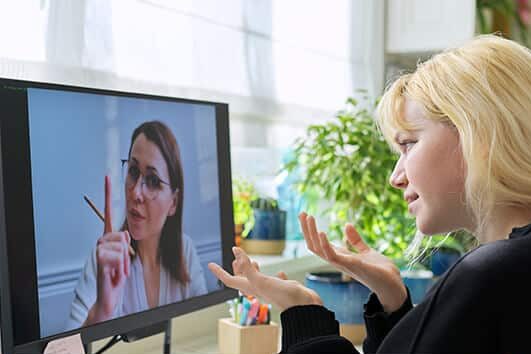Hypoarousal is when your mind and body become so overwhelmed by trauma or stress that they under-function, paralyzing your ability to respond. Remaining in this state can lead to depression, fatigue, and social isolation, so it’s important to find support as soon as possible. There are effective methods of treating hypoarousal, including virtual therapy in California, that give you tools to feel more calm, present, and engaged again.
What is Hypoarousal?
What is hypoarousal? A hypoarousal trauma response means that in the face of trauma or stress, your parasympathetic response isn’t matched by your sympathetic response. You need your sympathetic nervous system to energize you to act and your parasympathetic nervous system to process your experiences and rest. Your “window of tolerance” is your capacity to tolerate intense emotions and stress and to integrate them in healthy, effective ways. You are within our window of tolerance when your sympathetic nervous system and parasympathetic nervous system are in balance, and as a result, you feel calm and present.
If you’re faced with more stress than you can handle, you become dysregulated. When dysregulated, you can become sympathetic dominant (hyperarousal) or parasympathetic dominant (hypoarousal). You can’t feel grounded or respond appropriately in the face of stress. A virtual therapist can help you get back from hypoarousal to feeling more engaged and present again.
Symptoms and Signs of Hypoarousal
Hypoarousal symptoms may include:
- Numbness.
- Lethargy.
- Dissociation.
- Detachment.
- Depression.
- Shallow breathing.
- Brain fog.
- Low blood pressure.
- Less sensitivity to pain.
- Difficulty sleeping.
- Difficulty eating.
The Traumatic Impact and Chronic Hypoarousal
A traumatic experience, especially when you feel helpless, sometimes leads to chronic hypoarousal that continues long past the event. The impact of this trauma may impact your life in these ways if it continues long-term:
- Feeling numb to both positive and negative events.
- Inability to respond to other people and situations with your usual clarity and energy.
- Difficulty completing work.
- Relationship challenges.
- Decision paralysis.
- Brain fog.
- Hopelessness.
Addressing Hypoarousal: Therapeutic Tools and Techniques
Seeking professional support when you experience hypoarousal helps prevent the development of more serious mental health issues and increases your likelihood of full recovery. Evidence-based tools for hypoarousal include:
- Trauma-focused therapy.
- Mindfulness-Based Therapy.
- Cognitive Behavioral Therapy (CBT).
- Medication.
These therapy techniques can be used even virtually to increase your awareness of your feelings and physical experiences, allowing you to be in the moment rather than paralyzed. The right medication may also balance brain chemistry. Activities that heighten your awareness of your senses help reduce hypoarousal. Tools for hypoarousal that may be used in therapy and practiced on your include:
- Physical activity.
- Meditation.
- Mindfulness.
- Sensory.
- Art.
- Music.
- Journaling.
Virtual Therapy in California: A Modern Solution

Online therapy existed before COVID-19, but the pandemic forced most therapists and clients to become adept at meeting online. Health and insurance regulations that once mandated in-person sessions became more flexible and allowed for the growth of online services in every field, including behavioral health. Many therapists have continued virtual sessions because so many clients prefer that modality to have an in-person office and sessions. Studies have shown that treatment outcomes are similar between in-person and virtual sessions for clients who are not in crisis and need of physical monitoring and stabilization.
Advantages of virtual appointments include:
- You can meet anytime from any location.
- You can access therapists outside your commute range.
- You have a wider range of choices of providers with various specialties, including hypoarousal.
- Confidentiality is increased by not visiting an office.
- You can still attend a session if you struggle with leaving your home.
As long as a therapist uses a HIPAA-compliant platform and you attend your session from a private location, your confidentiality is ensured. You also want to make sure your therapist is licensed to practice in the state you’re in during your appointment. Mindfuli is one personalized online treatment platform in California that helps you connect with the best treatment and therapist for your needs.
How to Seek and Utilize Virtual Therapy in California
If you’re wondering how to get out of hypoarousal, a therapist can help you begin your journey to recovery. They will explore your symptoms, experiences, and goals with you and help you learn effective ways to cope with stress and trauma. Call Mindfuli at 888-703-3004 to learn about its reputable therapy services in California delivered through a virtual online platform.
Frequently Asked Questions About Hypoarousal Virtual Therapy in California
What is hypoarousal, and how is it different from hyperarousal?
Hypoarousal is a kind of freeze response that occurs when you become too overwhelmed. Your parasympathetic nervous system primarily responds, and your sympathetic nervous system doesn’t respond or act in its usual balance. Rather than being compelled to act, you feel a sense of paralysis or helplessness.
How can one recognize the symptoms of hypoarousal?
Feeling numb, dissociated, depressed, exhausted, helpless, or frozen may be a sign that you are in a state of hypoarousal. Some with hypoarousal find it difficult to sleep or eat well, and many struggle with social isolation as they aren’t motivated to initiate or engage in social plans.
Can trauma lead to chronic hypoarousal?
Going into a hypoarousal state during trauma may make it difficult for some people to re-engage with their feelings and others afterward. Treatment stimulating your senses and sympathetic nervous system can help you regain balance.
What tools or techniques are most effective for treating hypoarousal?
Therapy techniques that help you be more mindful, present, and calm effectively treat hypoarousal. Medication is also useful for some. On your own, exercising, listening to music, creating art, journaling, or taking time to notice your senses in other ways can help you re-engage with yourself and others.
Why is virtual therapy becoming a preferred solution for many in California?
Virtual therapy is both convenient and effective. It allows you to have a therapy session from any location, as well as choose from a wider variety of therapists who specialize in trauma and hypoarousal therapy.
How does an online treatment platform for hypoarousal work?
An online treatment platform for hypoarousal provides you and your therapist with a convenient, confidential way to discuss your experiences and symptoms, create goals for your treatment, and practice coping skills for your future.
Are virtual mental health services in California as effective as in-person sessions?
Virtual mental health services in California can be as effective as in-person sessions. Whether online or in person, a therapist will gather information about your experiences and goals and share ways to cope with and recover from your symptoms.
